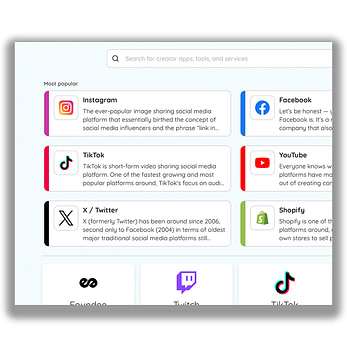Data Connections
Understanding the different types of data connections in RootNote and when to use them.

The Relationships Between Apps And Data
When you add an app or platform to a creator's Creator Stack, you still need to decide if and how you want to bring data in from that platform to RootNote. There are several different ways you could sync data between an app and RootNote, and most apps have different options. Typically, the easiest option is if an app has an API connection — but only a few do, and even in that case, you may also want to include data that doesn't come from the API. That's where file uploads or manual entry may come in handy.

App Data Pages
Every app has its own data page. You access these data pages by heading to your Creator Stack and then clicking on the app. These pages help you do critical things in RootNote, including connecting to the apps, uploading data, and accessing manual data entry. They also show you the status of your connections and include raw data cards.


API Connections
API connections are secure connections between an app or platform and RootNote. These are established by a user clicking on a button to connect within RootNote and then going through the process of logging in to the other platform and granting access between RootNote and that platform. The pros of these connections are that they're very secure and allow for an automatic transfer of data from the app to RootNote. As a rule of thumb, if you have the option to connect a platform to RootNote via the API connection, you'll want to do it. The downside of these types of connections is that sometimes the API only allows for a certain type of data to get transferred. That means that if there's a very specific piece of data from an app or platform that you want to show up in RootNote, you might have to do it using a different method. Every platform's API is different, and they do go through changes depending on what that platform wants to allow to pass through its API. Still, the benefits of using API connections far outweigh the alternative of forgoing them altogether.

Publicly Available Data
Some apps in RootNote will allow you to start pulling in data simply by typing in a user's handle (that thing that typically begins with an @ sign). In this case, RootNote is pulling in what is known as "publicly available data." The pro to this method is that you don't need to have the login credentials for a user in order to start automatically pulling in data. The cons are that you're only going to be able to pull in data any random person could see simply by going to that user's profile. That makes it less robust than an API connection. Still, it's a great option for users who need a fast way to start pulling in data for certain creator accounts, including accounts they don't have credentialed access to. If you don't have access to login credentials but know who might, you can click the "Don't have access to ____" text under the connect button, enter an email or phone number, and RootNote will send a request to that user to connect their accounts using their credentials!

File Uploads
Users can upload data files using RootNote's smart File Upload tool to make large quantities of data ingestion a breeze. For more information on this method of entry, click here.

Manual Data Entry
Manual data entry is a valuable tool for a few scenarios. Of course, if there's a platform that has no other way of exporting data, manual entry allows you to make sure all your data still shows up beautifully in RootNote. Manual entry can also work as a hybrid option when there's a specific type of data from an app or platform that you want to track — but it isn't part of the API or file uploads. Basically, manual entry means you've always got a way to get the data you want into RootNote. Read more about it here.
Still need help? Feel free to reach out to [email protected] with questions.
